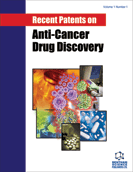Abstract
One of the greatest challenges in cancer drug therapy is to maximize the effectiveness of the active agent while reducing its systemic adverse effects. To add more, many widely-used chemoterapeutic agents present unfavorable physicochemical properties (e.g. low solubility, lack of chemical or biological stability) that hamper or limit their therapeutic applications. All these issues may be overcome by designing adequate drug delivery systems; nanocarriers are particularly suitable for this purpose. Nanosystems can be used for targeted-drug release, treatment, diagnostic imaging and therapy monitoring. They allow the formulation of drug delivery systems with user-defined characteristics regarding solubility, biodegradability, particle size, release kinetics and active targeting, among others. This review (Part I) focuses on recent patents published between 2008 and the present day, related to nanospheres, nanocapsules and nanogels applied to anticancer drug therapy. Other nanosystems is covered in a second article (Part II).
Keywords: Anticancer drug therapy, drug delivery, hydrogels, nanocapsules, nanogels, nanoshells, nanospheres, patents.
Recent Patents on Anti-Cancer Drug Discovery
Title:Applications of Nanosystems to Anticancer Drug Therapy (Part I. Nanogels, Nanospheres, Nanocapsules)
Volume: 9 Issue: 1
Author(s): Alan Talevi, Melisa E. Gantner and María E. Ruiz
Affiliation:
Keywords: Anticancer drug therapy, drug delivery, hydrogels, nanocapsules, nanogels, nanoshells, nanospheres, patents.
Abstract: One of the greatest challenges in cancer drug therapy is to maximize the effectiveness of the active agent while reducing its systemic adverse effects. To add more, many widely-used chemoterapeutic agents present unfavorable physicochemical properties (e.g. low solubility, lack of chemical or biological stability) that hamper or limit their therapeutic applications. All these issues may be overcome by designing adequate drug delivery systems; nanocarriers are particularly suitable for this purpose. Nanosystems can be used for targeted-drug release, treatment, diagnostic imaging and therapy monitoring. They allow the formulation of drug delivery systems with user-defined characteristics regarding solubility, biodegradability, particle size, release kinetics and active targeting, among others. This review (Part I) focuses on recent patents published between 2008 and the present day, related to nanospheres, nanocapsules and nanogels applied to anticancer drug therapy. Other nanosystems is covered in a second article (Part II).
Export Options
About this article
Cite this article as:
Talevi Alan, Gantner E. Melisa and Ruiz E. María, Applications of Nanosystems to Anticancer Drug Therapy (Part I. Nanogels, Nanospheres, Nanocapsules), Recent Patents on Anti-Cancer Drug Discovery 2014; 9 (1) . https://dx.doi.org/10.2174/1574891X113089990035
| DOI https://dx.doi.org/10.2174/1574891X113089990035 |
Print ISSN 1574-8928 |
| Publisher Name Bentham Science Publisher |
Online ISSN 2212-3970 |
Related Books
 80
80
- Author Guidelines
- Bentham Author Support Services (BASS)
- Graphical Abstracts
- Fabricating and Stating False Information
- Research Misconduct
- Post Publication Discussions and Corrections
- Publishing Ethics and Rectitude
- Increase Visibility of Your Article
- Archiving Policies
- Peer Review Workflow
- Order Your Article Before Print
- Promote Your Article
- Manuscript Transfer Facility
- Editorial Policies
- Allegations from Whistleblowers
Related Articles
-
Targeting the BRCA1/2 Tumor Suppressors
Current Drug Targets Inhibitory Smad7: Emerging Roles in Health and Disease
Current Molecular Pharmacology Emerging Targeted Therapies for Pediatric Acute Myeloid Leukemia
Recent Patents on Anti-Cancer Drug Discovery Combined Modality Treatment of Glioblastoma Multiforme: The Role of Temozolomide
Reviews on Recent Clinical Trials New Alkyl-Lipid Blockers of SK3 Channels Reduce Cancer Cell Migration and Occurrence of Metastasis
Current Cancer Drug Targets Novel Experimental Design for Steady-state Processes: A Systematic Bayesian Approach for Enzymes, Drug Transport, Receptor Binding, Continuous Culture and Cell Transport Kinetics
Medicinal Chemistry Telomeric G-Quadruplex Architecture and Interactions with Potential Drugs
Current Pharmaceutical Design Annexins in the Central Nervous System: Are they Neuroprotective or Proapoptotic Agents?
Medicinal Chemistry Reviews - Online (Discontinued) Stilbenes and Xanthones from Medicinal Plants as Potential Antitumor Agents
Current Bioactive Compounds Nanocarriers Conjugated with Cell Penetrating Peptides: New Trojan Horses by Modern Ulysses
Current Pharmaceutical Biotechnology Naturally-occurring Dimers of Flavonoids as Anticarcinogens
Anti-Cancer Agents in Medicinal Chemistry SDResU-Net: Separable and Dilated Residual U-Net for MRI Brain Tumor Segmentation
Current Medical Imaging Brain Tumor Detection from MR Images Employing Fuzzy Graph Cut Technique
Recent Advances in Computer Science and Communications Serpins for Diagnosis and Therapy in Cancer
Cardiovascular & Hematological Disorders-Drug Targets In Vivo Anticancer Activity, Toxicology and Histopathological Studies of the Thiolate Gold(I) Complex [Au(Spyrimidine)(PTA-CH<sub>2</sub>Ph)]Br
Anti-Cancer Agents in Medicinal Chemistry Effective Treatment of Human Lung Cancer by Targeting Tissue Factor with a Factor VII-Targeted Photodynamic Therapy
Current Cancer Drug Targets Edema-mass Ratio Based On Magnetic Resonance Imaging As A Preoperative Diagnostic Factor For Posterior Fossa Metastasis
Current Medical Imaging The Functional Role of Oncogenic LncRNA BCAR4 for Cancer Outcome
Current Pharmaceutical Design The Interplay between G-quadruplex and Transcription
Current Medicinal Chemistry Apoptosis is a Critical Cellular Event in Cancer Chemoprevention and Chemotherapy by Selenium Compounds
Current Cancer Drug Targets


























